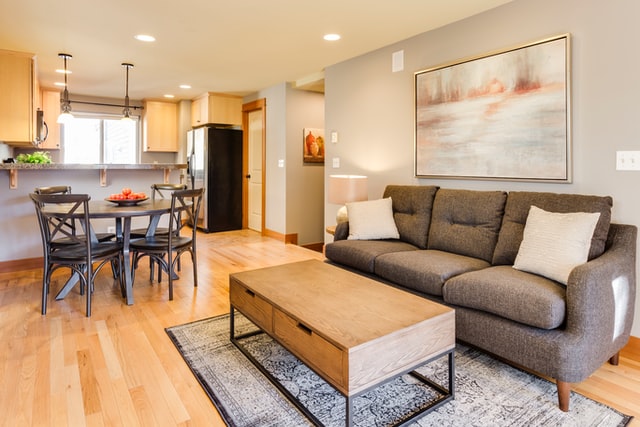Radiant floor or radiant heating systems supply heat through the floor, wall panels, or ceiling of your home. This system works by delivering heat from a hot surface to the room using a process called infrared radiation. It works in the same way you feel the heat coming from a stovetop, even if you’re across the room. The method uses convection which circulates heat throughout the room as the warm air from the floor rises into the air around you. This form of heating was first used in Korea and China around 5,000 B.C. when heat from fireplaces was sent through flues built into the earth below, allowing the heat to conduct onto the surface as it radiated into the rooms around it. It wasn’t until around 1907 that radiant floor heating became popular in the United States. However, famous architect Frank Lloyd Wright really brought it into the spotlight when he began using it in many of his projects, including public administration buildings and private homes. Today, this heating style is found in many homes and uses electricity to generate heat. The three main ways to get radiant floor heating are air, water (hydronic), or electricity. Newer homes often employ wires built into the flooring to generate warmth throughout a space.
The Benefits and Pros of Radiant Floor Heating
There are many benefits to choosing this type of heating for your home, including safety, energy efficiency, and more. Let’s take a closer look at some of the many pros of choosing this form of home heating.
- Electrical radiant heat: This style of radiant floor heating uses wires or cables built into the floor or subfloor. Flooring materials like polished concrete with a high thermal mass will keep the heat stored in the house for up to eight to 10 hours, making it an energy-efficient choice for some homes. This option is also a popular choice for bathrooms since it allows you to step on nice, warm floors when getting out of the bath or shower. It may be more expensive up front, but electrical radiant heat can save homeowners a significant amount in energy costs over time.
- Air radiant heat: Air radiant heating systems are the least popular and least-used systems of the three. It uses forced air to warm up a room but dissipates rather quickly. You likely won’t find this option in newer homes since electrical and hydronic are much more effective at keeping rooms warmer for longer periods of time. However, if you have a solar-air heating system, it may work in conjunction with that to keep your home at a reasonable temperature.
- Hydronic radiant heat: Water-based or hydronic systems are cost-effective and pump heated water from a boiler through tubing underneath the floor. Newer systems allow you to control the flow of hot water through the tubing by using zoning valves and thermostats to regulate the room’s temperature, so you don’t always need to have it running in rooms that are not being used. Overall, this system is the most eco-friendly and cost-effective option for most homeowners.
- Energy-efficient: Radiant heating systems are energy-efficient and can save you money over the long run. Unlike forced air that must constantly run to keep a room warm, radiant heat dissipates slowly and uses convection to keep the warm air moving. It also prevents duct loss that is common with forced air systems, ensuring that your home remains warm once the heat is operational. Because heat rises, it’s also a much more effective method of heating overall. The average homeowner can save around 15-percent in their monthly energy costs with radiant heating systems.
- Easy and safe to use: Because you don’t need to worry about dust, pet dander, and other debris floating through the ductwork and the air in your home, radiant floor heating is a good option for people with allergies or those who suffer from dry noses during the wintertime. It’s also safe for pets, children, and elderly family members. This form of heating is easy to use and can be turned on or off with a simple switch. Thermostats make it easy to measure the temperature in your home so you can adjust as needed.
- Space-saving: With radiant floor heating, you won’t need to worry about bulky heaters, radiators, or mess from fireplaces. Since this form of heating is embedded into the floor or comes from small panels or registers, it doesn’t take up much space in the home. You also won’t need to deal with issues like annual chimney cleanings, messy soot, or a possible house fire like you might from a fireplace.
- Easy installation and maintenance: Radiant heating systems are easy to install and will work with most floor coverings like tile, concrete, and many other materials. Hydronic heating pipes are leak-free, and electrical systems use cables or wires embedded into the floor, so there are no worries about keeping them in good condition. And, maintaining this home heating system is easy and not very costly, making it a very smart option for homeowners. Be sure to acquire all the equipment you will need, some are shown here.
- Long lifespan: Typical HVAC systems require regular maintenance and a lot of moving parts to remain operational. However, radiant heating is less complex, which means it has quite an impressive lifespan. If the system is installed correctly, it can last for decades with very few issues, if any.
Maintenance for Radiant Floor Heating
Of course, proper maintenance will help to protect your investment. Here is some more information about maintaining your radiant floor heating system.
What’s required: There are some key things to consider when maintaining your radiant heating system, including:
o Pressure check: An annual pressure check is recommended if you have hydronic heating to ensure that the pipes are in good condition. If a leak or breach is present, it can make your heat less efficient and may waste energy and money.
o Cleaning: The pump, pressure tank, and boiler should be cleaned as often as possible to ensure that everything is working properly. A clogged or dirty pump can make the system work harder, increasing energy costs. This simple cleaning can be done by most HVAC professionals.
o Condition of pumps and valves: All parts, including pumps and valves, should be inspected regularly to ensure that each piece is in good working order. If a part is broken or worn out, they’re typically inexpensive and easy to replace. The sooner you notice a problem with the valves or pump, the better.
o Type of floor: Depending on the type of flooring and system you have, most radiant heating is self-operational, and your floors won’t need much additional attention. In fact, once electrical radiant heating is installed, all you need to worry about is making sure that the thermostat is working correctly to keep your home and your floors nice and warm, you will need the help of a handyman for a secure installation.
Don’t neglect it: Although radiant heating systems are low maintenance, you should always contact a trusted professional if you notice an issue. If your home is struggling to keep warm or the floors feel cold to the touch when the heat is on, you may need a service call to troubleshoot the problem. It could be related to the electrical wiring connection, an issue with the boiler or pump, or a problem with the pipes if you have a hydronic system.
Basic maintenance: Ensure that your home’s thermostat is working properly and that your boiler and pump are in good condition. Listen for any unusual noises which could indicate a problem with a leaky pipe or an issue with the pressure valve. Test your system before winter arrives so you can pinpoint any issues and catch them early so your home will stay warm during the colder months of the year. Keep the boiler clean and clear of dirt and debris to keep your system running optimally.
Inspection: Just like any other home heating or cooling system, an annual inspection is highly recommended. This will ensure that everything is working as it should be, and it will help to keep your radiant floor heating in great shape for many years to come.
Newest Technology: Radiant Floor Cooling
Radiant floors are often only used for heating. We are just now starting to see some used for cooling, but this tends to only occur in office buildings where workers wear shoes. Radiant cooling floors are less popular among homeowners because home occupants don’t want to walk on cold floors when radiant ceiling panels can be used to cool the environment instead.
The reason that radiant cooling is a relatively new technology is that we had to get to a point where we could control the temperature of the water within panels or floors to keep it from dropping below the environment’s dew point temperature, which is the point when condensation forms. For the longest time, no one could monitor the dew point, so radiant cooling was never possible.
Saul De Los Santos from Messana Hydronic Technologies mentions that through the use of our Messana mSense room comfort sensors, Messana can measure the room’s relative humidity and figure out the dew point temperature. From there, Messana mControls can regulate the system to ensure that the temperature of the water within the panels never falls below the dew-point. Additionally, if one of our Air Treatment Units is used, we can dehumidify the environment to lower the dew-point temperature, increasing the cooling capacity of our panels!
There are circumstances that you should prioritize when picking the most suitable floors for your home. The value of each one differs depending on the place/area you wish to create. For wet sections (e.g. bathrooms and laundry), you need floors that are non-slip, low-maintenance, and secure to walk on. For the living room, convenience is the priority. For hallways, smoothness of travel and ergonomics are important.
As you can see, choosing a radiant floor heating system is a smart investment. Thanks to its ease of use, safety, and energy efficiency, more homeowners choose this option over other methods, including gas, oil, and forced air. With minimal maintenance, you can enjoy a toasty warm home all winter long with minimal worry. This type of heating is also an excellent option for bathrooms so that you can enjoy a comfortable temperature and warm floors. No matter where you choose to install it, choosing a radiant floor heating system is a smart way to maintain a comfortable temperature inside your house throughout the cold winter months.




